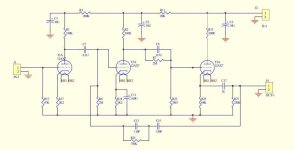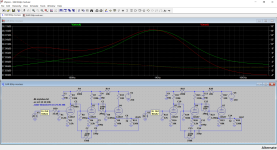Hi everyone. I have been very sick lately, and have missed participating on my favorite forums.
Anyway, I am looking for a way to step down phono cartridges in the 5 to 10mv range to around 2mv without too much sonic degradation.
Is there a reasonable and affordable way to accomplish this?
Anyway, I am looking for a way to step down phono cartridges in the 5 to 10mv range to around 2mv without too much sonic degradation.
Is there a reasonable and affordable way to accomplish this?
Last edited:
Early MM and MI. I may want to make a combined unit that controls the output, capacitance and impedance of the cartridges.
I believe that doing it all at the output of the cartridge will be the best place to do it.
Dual high quality volume pots perhaps?
I believe that doing it all at the output of the cartridge will be the best place to do it.
Dual high quality volume pots perhaps?
Last edited:
Use an L pad attenuator (two metal film resistors) for each channel of the high output cartridge.
OK. So I am currently looking at using a Shure M55e which has an output of 6.2mv and 630-Ohms impedance. If I use an l-pad circuit to drop it down down to 2.2mv, what value of resistors would I need to use?
The sum of the two resistors should be 47k.
The attenuation factor is: R2 / ( R1 + R2 ) = R2 / 47k
where R1 is the series resistor, and R2 is the shunt resistor.
For example, if the attenuation factor is 2.2/6.2 = 0.355 (which is -9.0dB)
then 0.355 = R2/47k or R2 = 16.68k
and R1 = 47k - R2 = 30.31k
Any added load capacitance should be connected before the L pad.
The attenuation factor is: R2 / ( R1 + R2 ) = R2 / 47k
where R1 is the series resistor, and R2 is the shunt resistor.
For example, if the attenuation factor is 2.2/6.2 = 0.355 (which is -9.0dB)
then 0.355 = R2/47k or R2 = 16.68k
and R1 = 47k - R2 = 30.31k
Any added load capacitance should be connected before the L pad.
Not really, unless the reason you want to do this is that your preamp doesn't have enough headroom to handle a higher output cartridge, in which case I'd look into fixing that first. 6 mV isn't outrageous, any competently designed MM preamp should be able to handle it, even if it's spec'd with a nominal input level of 2 mV.I believe that doing it all at the output of the cartridge will be the best place to do it.
If it's simply a matter of keeping a consistent volume when switching between cartridges with different outputs, the output of the preamp is the place to do it.
Noise is equal to K T B R G S/N where K is Boltzmann's constant, T is temperature in Kelvin, B is Bandwidth, R is resistance, G is the next stage Gain and S/N the signal to noise ratio. The further forward you adding resistance will affect overall system noise floor. Is that what you want besides attenuating the signal? Maybe a signal step down transformer may be better.
Why do you want to attenuate the MM pick-up?
Well, between the high gain of my preamp (around 55dB) and my headphone amps high sensitivity, even my 2.7mV cartridge is a bit too loud on some records.
So you are assuming (or know) that your pre-amp is overloading. What pre-amp are you using?
EDIT: You realize you can buy RCA attenuators on line.
https://www.amazon.com/Harrison-Lab...16-a564-67eafd986512&pd_rd_i=B0006N41B0&psc=1
EDIT: You realize you can buy RCA attenuators on line.
https://www.amazon.com/Harrison-Lab...16-a564-67eafd986512&pd_rd_i=B0006N41B0&psc=1
Last edited:
Not really, unless the reason you want to do this is that your preamp doesn't have enough headroom to handle a higher output cartridge, in which case I'd look into fixing that first. 6 mV isn't outrageous, any competently designed MM preamp should be able to handle it, even if it's spec'd with a nominal input level of 2 mV.
It can handle it. The problem is too much gain.
If it's simply a matter of keeping a consistent volume when switching between cartridges with different outputs, the output of the preamp is the place to do it.
Either that or step down transformers I suppose. But using 2 quality mono attenuation pots should cost less to implement, and give me more control over the balance.
That's way too high for an MM pre. I'd definitely look into reworking it to a more reasonable 35-40 dB of gain, rather than attenuating what has been unnecessarily amplified. Do you have the schematic?around 55dB
Does the pre-amp have a volume control or is it just a black box? If it has try turning it anti-clockwise, it usually works. 😳
That's way too high for an MM pre. I'd definitely look into reworking it to a more reasonable 35-40 dB of gain, rather than attenuating what has been unnecessarily amplified. Do you have the schematic?
It's a Chinese EAR 834p without a gain pot (gold and black circuit board).
The gain is useful for high output MC.
Attachments
Try placing a 47K resistor between J1,1 and T1a grid, effectively attenuating by 6dB, if still too loud then increase resistor to say 100K. If too low then decrease the resistor value until suitable volume reached.
You can do this on the input Connector not needing to remove any boards. It is interesting that there is no decoupling cap on the input. DC on the input can cause some real weird things happening. In fact first just connect the amp via a capacitor say 1 uF or so to establish that this is not the problem.
You can do this on the input Connector not needing to remove any boards. It is interesting that there is no decoupling cap on the input. DC on the input can cause some real weird things happening. In fact first just connect the amp via a capacitor say 1 uF or so to establish that this is not the problem.
Last edited:
If your cartridge is connected to J1 with DC on it, the coils will be magnetized and the cartridge will probably sound completely distorted. Is that your problem. I had the same cartridge in the 70s and it was connected to a Pioneer SA8100 with sensitivity being 2.5mV, it was never over-driven by this cartridge.
See attached. I get an actual gain for the stock circuit of ~49 dB, this may be due to the 12AX7 model I've used. The 250V supply is just a guess. Anyway, by replacing:
R17: 2k2 -> 10k
C7: 100n -> 33n
R8: 2M -> 560k
The gain drops by ~11 dB to ~38 dB, which is pretty standard for an MM pre. I've simulated the stock one with a voltage divider at the input adjusted to match the gain of the modded one so I could compare the curves better. The stock RIAA accuracy is +/- 0.13 dB, the modified one is +/- 0.15 dB, so negligible in practical terms (note the dB scale on the graph). In terms of noise, the stock + voltage divider gives a 20-20k RMS noise of ~361 uV, the modded one ~99 uV, so around 11 dB better, as expected.
You may want to give this a try, it's just half a dozen components and easily reversible if you don't like the result. Use a good quality PP cap for C7, like a Wima FKP.
R17: 2k2 -> 10k
C7: 100n -> 33n
R8: 2M -> 560k
The gain drops by ~11 dB to ~38 dB, which is pretty standard for an MM pre. I've simulated the stock one with a voltage divider at the input adjusted to match the gain of the modded one so I could compare the curves better. The stock RIAA accuracy is +/- 0.13 dB, the modified one is +/- 0.15 dB, so negligible in practical terms (note the dB scale on the graph). In terms of noise, the stock + voltage divider gives a 20-20k RMS noise of ~361 uV, the modded one ~99 uV, so around 11 dB better, as expected.
You may want to give this a try, it's just half a dozen components and easily reversible if you don't like the result. Use a good quality PP cap for C7, like a Wima FKP.
Attachments
- Home
- Source & Line
- Analog Line Level
- High Quality Step Down?

